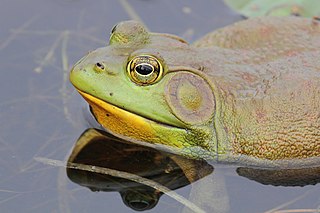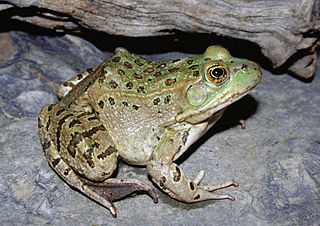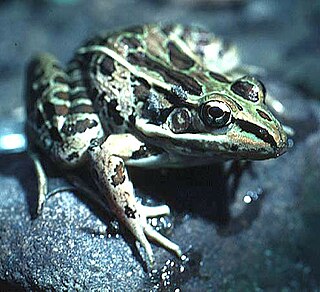
Leopard frog is a generic name used to refer to various species in the true frog genus Lithobates. They all have similar coloration: brown or green with spots that form a leopard pattern. They are distinguished by their distribution and behavioral, morphological, and genetic differences. The range of the various species of leopard frogs extends from the Hudson Bay in Canada, throughout the United States, throughout Mexico and other parts of Central America, and possibly the very northern section of South America.

The northern leopard frog is a species of leopard frog from the true frog family, native to parts of Canada and the United States. It is the state amphibian of Minnesota and Vermont.

Rana is a genus of frogs commonly known as the Holarctic true frogs, pond frogs or brown frogs. Members of this genus are found through much of Eurasia and western North America. Many other genera were formerly included here. These true frogs are usually largish species characterized by their slim waists and wrinkled skin; many have thin ridges running along their backs, but they generally lack "warts" as in typical toads. They are excellent jumpers due to their long, slender legs. The typical webbing found on their hind feet allows for easy movement through water. Coloration is mostly greens and browns above, with darker and yellowish spots.

The southern leopard frog is a species of true frog. It is native to eastern North America from Kansas to New York to Florida. It is also an introduced species in some areas.

The Plains leopard frog It is sometimes referred to as Blair's leopard frog, named after the noted zoologist and University of Texas professor, Dr. W. Frank Blair.

The crawfish frog is a medium-sized species of frog native to the prairies and grasslands of the central United States. It gets its name because it inhabits the burrows of crayfish for most of the year. They have defined golden or black circles all over their body.

The Vegas Valley leopard frog is a species of frog previously declared extinct. Once it occurred in the Las Vegas Valley, as well as Tule Springs, Clark County, southern Nevada, United States of America, at elevations between 370 and 760 m. It was believed to be the only frog endemic to the United States to have become extinct in modern times.

Lithobates is a genus of true frogs, of the family Ranidae. The name is derived from litho- (stone) and the Greek bates, meaning one that treads on rock, or rock climber.

The gopher frog is a species of frog in the family Ranidae, endemic to the south-eastern United States. It primarily inhabits the threatened sandhill communities, flatwoods, and scrub in the Atlantic coastal plain, where it is usually found near ponds.

The Chiricahua leopard frog is a species of frog in the family Ranidae, the true frogs. It is native to Mexico and the United States. Its natural habitats are temperate forests, rivers, intermittent rivers, swamps, freshwater lakes, intermittent freshwater lakes, freshwater marshes, intermittent freshwater marshes, freshwater springs, ponds, and open excavations. It is threatened by habitat loss and chytrid fungus to such an extent that it has been eliminated from 80% of its former habitat. The Phoenix Zoo, Arizona's Department of Game and Fish, and the USFWS are trying to mitigate threats through captive breeding and reintroduction efforts.
The Patzcuaro frog is a species of frog in the family Ranidae. Within the former, broadly defined genus Rana, it belongs to the Rana montezumae subgroup of the Rana pipiens complex. It is endemic to the Michoacán state, Mexico, where it is locally known as rana de Pátzcuaro. It occurs in Lake Pátzcuaro, Lake Cuitzeo, and the surrounding streams in Río de Morelia.

Forrer's grass frog or Forrer's leopard frog, Lithobates forreri, is a species of frog in the family Ranidae found in Mexico and Central America through Guatemala, El Salvador, Honduras, and Nicaragua to Costa Rica. It is a widespread and common frog found in lowland and seasonal tropical forests. It can also adapt to man-made habitats such as flooded agricultural lands and other water content systems. Reproduction requires permanent pools and lagoons.
Moore's frog is a species of frog in the true frog family (Ranidae). It is endemic to Mexico.
The Maya Mountains frog is a species of frog in the family Ranidae found in Belize and possibly Guatemala. Its natural habitats are subtropical or tropical moist lowland forests, moist savanna, and rivers. This anuran is endemic to the Belizean pine forests ecoregion.
The Guatemala plateau frog is a species of frog in the family Ranidae. It occurs in Guatemala and southern Mexico. It is impossible to morphologically distinguish this species from Lithobates forreri and Lithobates brownorum, and the validity of it has been questioned. It is an uncommon frog that inhabits cloud forests, including degraded forest, and grassland. Breeding takes place in streams and small temporary ponds. It is threatened by habitat degradation caused by agricultural encroachment, wood extraction, human settlement, and water pollution.
The smooth-backed frog is a species of frog in the family Ranidae endemic to Mexico.
Tlaloc's leopard frog, or rana de Tláloc in Spanish, is a species of frog in the family Ranidae endemic to the Valley of Mexico. It is most likely extinct.

Vaillant's frog is a species of frog in the family Ranidae found in Central America. Its natural habitats are subtropical or tropical dry forests, subtropical or tropical moist lowland forests, subtropical or tropical swamps, rivers, swamps, freshwater lakes, intermittent freshwater lakes, freshwater marshes, intermittent freshwater marshes, rural gardens, heavily degraded former forests, water storage areas, ponds, and canals and ditches.

The lowland leopard frog is a species of frog in the family Ranidae that is found in Mexico and the United States.

The green frog is a species of frog native to eastern North America. The two subspecies are the bronze frog and the northern green frog.














